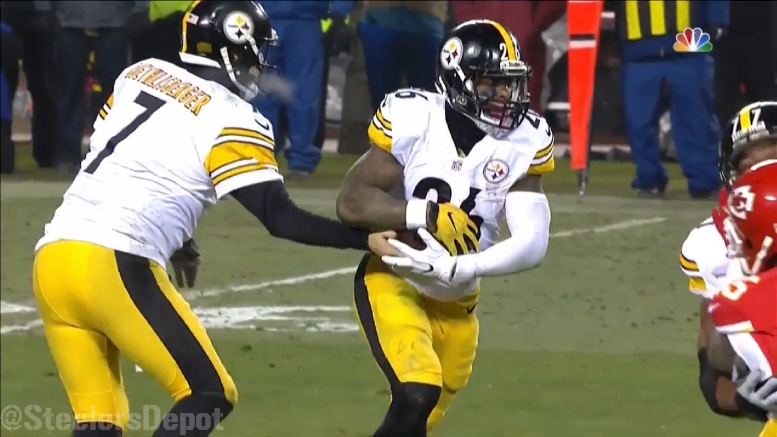At some point prior to March 1 the Pittsburgh Steelers are expected to place the franchise tag on running back Le’Veon Bell and ahead of that happening, former NFL player agent Joel Corry has now written a lengthy post that details how the long-term contract negotiations might go for both sides from that point forward. Not only does Corry detail how the franchise tag and Bell’s 2016 season might help his cause when it comes to him receiving very lucrative money from the Steelers, but also how the declining running back market might hurt him some.
In an effort to not regurgitate a lot of what Corry has written about Bell and his upcoming contract negotiations with the Steelers in the coming weeks and months, I thought now might be a great time to look back at the deals that were signed by the last two NFL running backs who were issued the franchise tag. Those two running backs were Matt Forte and Ray Rice, who were both tagged in 2012 by the Chicago Bears and Baltimore Ravens respectively.
First, it’s probably worth noting that the franchise tag for running backs in 2012 was $7.74 million.
If you look below at the four-year deal that Forte ultimately signed with the Bears just ahead of the 2012 deadline, you will notice that he received all of $9.8 million in his first season and that was just slightly more than the tag amount that year. Additionally, his 2013 base salary of $1.7 million was guaranteed for injury through the fifth day of the 2013 league year, at which time it became fully guaranteed. And, his 2013 roster bonus of $4 million was due to him on third day of 2013 league year and it was guaranteed for injury and skill at the time he signed the contract. As Pro Football Talk noted at the time, the $17.1 million in quantified guaranteed money that Forte received at signing barely exceeded the money he would have earned under the franchise tag in 2012 and 2013.
In short, Forte wound up signing a very team-friendly contract with the Bears and he ultimately played it out and missed just four regular season games with three of those coming in his final year, 2015. While he didn’t pocket the full $30.5 million because of missed games, he came very close to it.
Before I move forward, it should be noted that Forte missed the final three games of the 2011 season because of an MCL injury.
| YEAR | SALARY | SIGNING BONUS | ROSTER BONUS | OTHER BONUS | WORKOUT BONUS | CASH FLOW | CAP CHARGE |
|---|---|---|---|---|---|---|---|
| 2012 | $800,000 | $1,000,000 | $5,000,000 | $0 | $0 | $9,800,000 | $6,800,000 |
| 2013 | $1,700,000 | $1,000,000 | $4,000,000 | $500,000 | $100,000 | $16,100,000 | $7,300,000 |
| 2014 | $5,500,000 | $1,000,000 | $0 | $1,000,000 | $100,000 | $22,700,000 | $7,600,000 |
| 2015 | $6,650,000 | $1,000,000 | $0 | $1,050,000 | $100,000 | $30,500,000 | $8,800,000 |
When it came to the deal that Rice signed with the Ravens just ahead of the 2012 deadline, that was structured very differently than the one that Forte signed with the Bears.
As you can see below, while Forte only received a $4 million signing bonus, Rice was given $15 million when he signed his five-year, $40 million contract. If you deduct the $1 million that Rice was set to earn in 2012 as part of performance escalator incentives, he effectively walked away from his contract signing with $17 million, as opposed to the $9.8 million that Forte received from the Bears. That $17 million was more than double the 2012 franchise tag amount. On top of that, Rice was virtually guaranteed to pocket $25 million through his first two years of his new contract and $27 million had he hit his incentives. The max Forte could have earned in the first two years of his new deal was $16.1 million.
| YEAR | SALARY | SIGNING BONUS | ROSTER BONUS | OTHER BONUS | WORKOUT BONUS | CASH FLOW | CAP CHARGE |
|---|---|---|---|---|---|---|---|
| 2012 | $2,000,000 | $3,000,000 | $0 | $1,000,000 | $0 | $18,000,000 | $6,000,000 |
| 2013 | $1,000,000 | $3,000,000 | $7,000,000 | $1,000,000 | $0 | $27,000,000 | $12,000,000 |
| 2014 | $4,000,000 | $3,000,000 | $0 | $1,000,000 | $0 | $32,000,000 | $8,000,000 |
| 2015 | $3,000,000 | $3,000,000 | $0 | $1,000,000 | $0 | $36,000,000 | $7,000,000 |
| 2016 | $3,000,000 | $3,000,000 | $0 | $1,000,000 | $0 | $40,000,000 | $7,000,000 |
As you can see, the Ravens bet heavily on Rice as they front loaded his contract of which he only played two years of. Not only did they ultimately eat three years worth of original signing bonus proration, they also had to eat a large amount of proration related to them giving Rice his 2013 $7 million option bonus as they gave that to him as a signing bonus in order to free up salary cap space that year.
So how does all of this relate back to Bell? For starters, as Corry alludes to in his recent post, Bell and his agent are likely going to want as close to two-years worth of franchise tag money in 2017 at signing. In Bell’s case, that amount is borderlining on $27 million. That’s quite a bit of money to throw at a running back with his history of injuries and suspensions even though he’s arguably the best player currently in the NFL at his position when he’s on the field.
Personally, I can’t see the Steelers fronting Bell that kind of money in year-one. Remember, Rice received $17 million when he signed which was right at the amount he would have received had he been franchised in 2012 and 2013. However, I can see Bell getting $27 million from the Steelers by next March as a new deal is likely to include an option/roster bonus of some kind that will be due a few days after the 2018 NFL league year arrives. Perhaps, Bell will also pocket $30 million by the end of the 2018 season as well in order to entice him to sign now as they would make sense.
Corry does an excellent job at pointing out the rubs for both sides. For starters, the Steelers really need to get a deal done with Bell if they tag him because if unable to do so, not only will they have to use a second franchise tag on him next year at this time, a new long-term deal for him at that point would be extremely hard to negotiate because of the third-year tag amount being that of a quarterback.
As for Bell, he will need to have to decide if he wants to gamble and play out the 2017 season under the tag and thus risk any future big earnings should he suffer another serious knee injury in addition to a declining running back market.
Let me include one other thing before wrapping this post up. Currently, Bell is represented by Adisa Bakari, who also represents Forte. Will that make a difference when it comes to the Steelers perhaps getting a somewhat team-friendly deal like the Bears were able to work out with Forte in 2012? It’s hard to say.
Regardless, once Bell is given the franchise tag, we might have to wait until near the July 15 deadline until a new long-term extension is agreed upon. I firmly believe a deal will get done and we’ll just have to wait and see just how much of it winds up being front-loaded.








